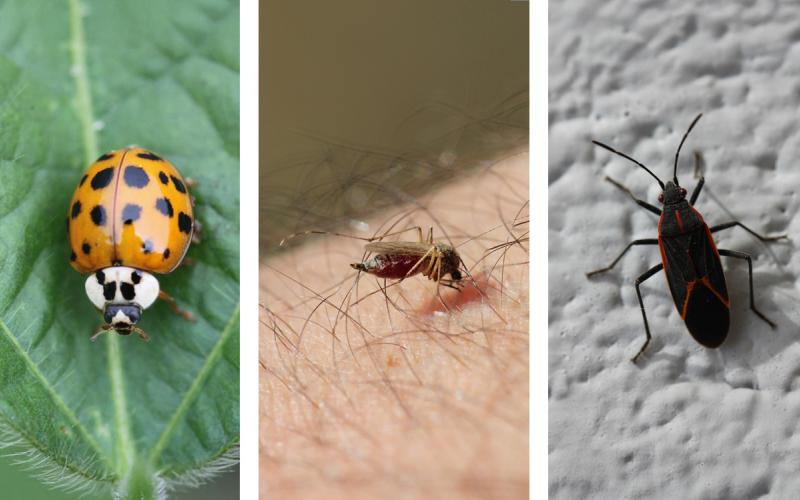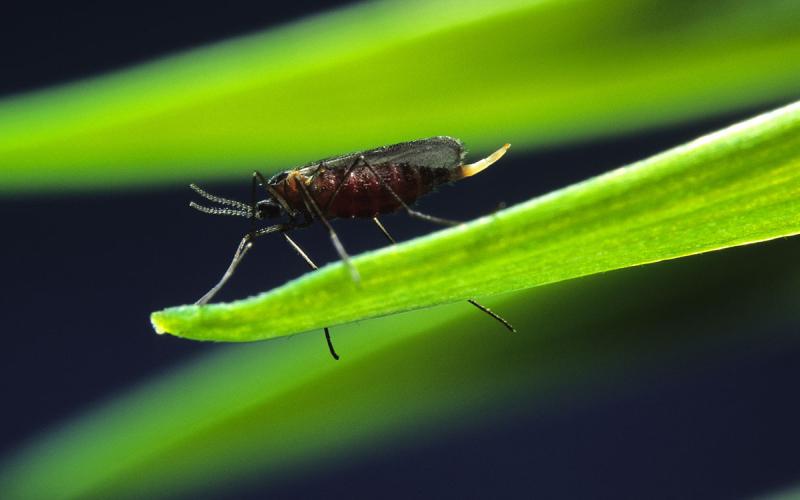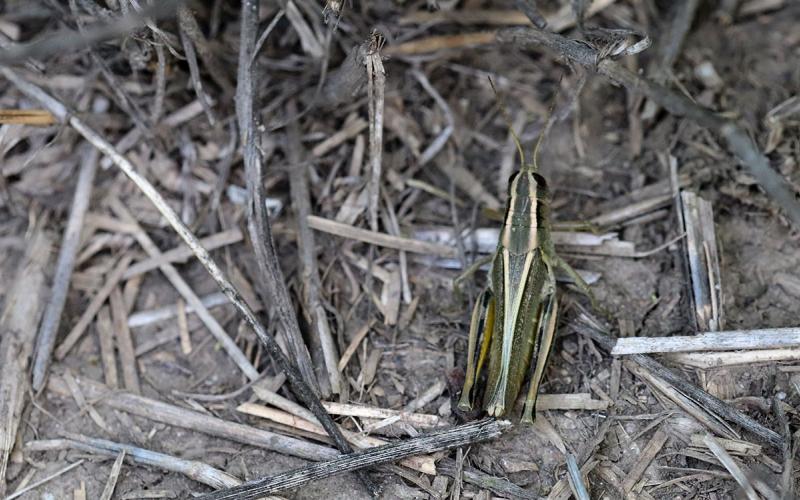Written with contributions by Shelby Pritchard, former SDSU Extension Pest Management Specialist.
Originally Submitted: June 30, 2022
Every year we receive questions regarding wheat stem sawfly activity in South Dakota. Wheat stem sawfly (Cephus cinctus) are primitive, wasp-like insects that belong to the family Cephidae within the order Hymenoptera (i.e. bees, wasps, ants). The larvae are considered serious pests of spring and winter wheat, and infestation can result in decreased quality and yield of the final product. In recent years, the northwestern and north central regions of South Dakota have struggled with the presence of sawfly populations in wheat fields.
Identification

Adults
- Adult wheat stem sawflies are long, slender, and approximately ¾ of an inch in length with grayish to smoky-brown wings.
- They have a black head and body with yellow legs and yellow markings across their abdomen (Figure 1-A).
- Female wheat stem sawflies possess a modified stinger (i.e. ovipositor) that they use to lay eggs with. The ovipositor slightly sticks out past the tip of the abdomen (Figure 1-B).
Eggs
- Wheat stem sawfly eggs are around 1/16 of an inch in length or less, crescent-shaped and creamy white in color.
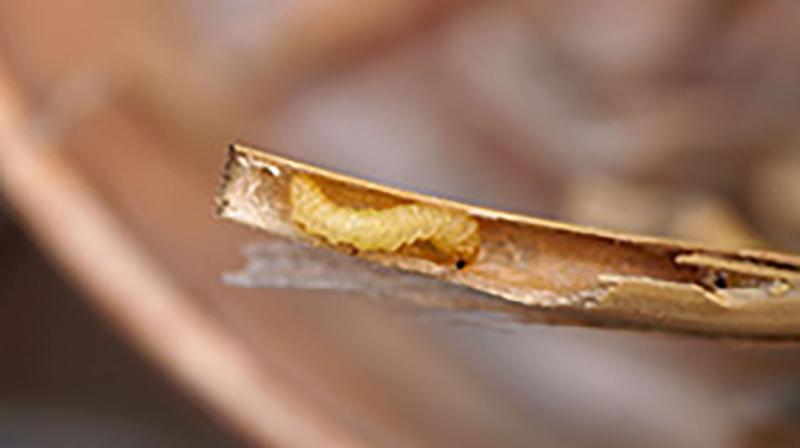
Larvae
- First instar larvae are pale in color, but later instars are creamy colored.
- They have textured bodies that make them appear wrinkled, and a brownish black head capsule.
- Wheat stem sawfly larvae have a distinct “S” shape both in and out of the host stem (Figure 2).
Pupae
- The wheat stem sawfly pupae resemble adults, but are white in color with their limbs remaining close to the body.
Lifecycle
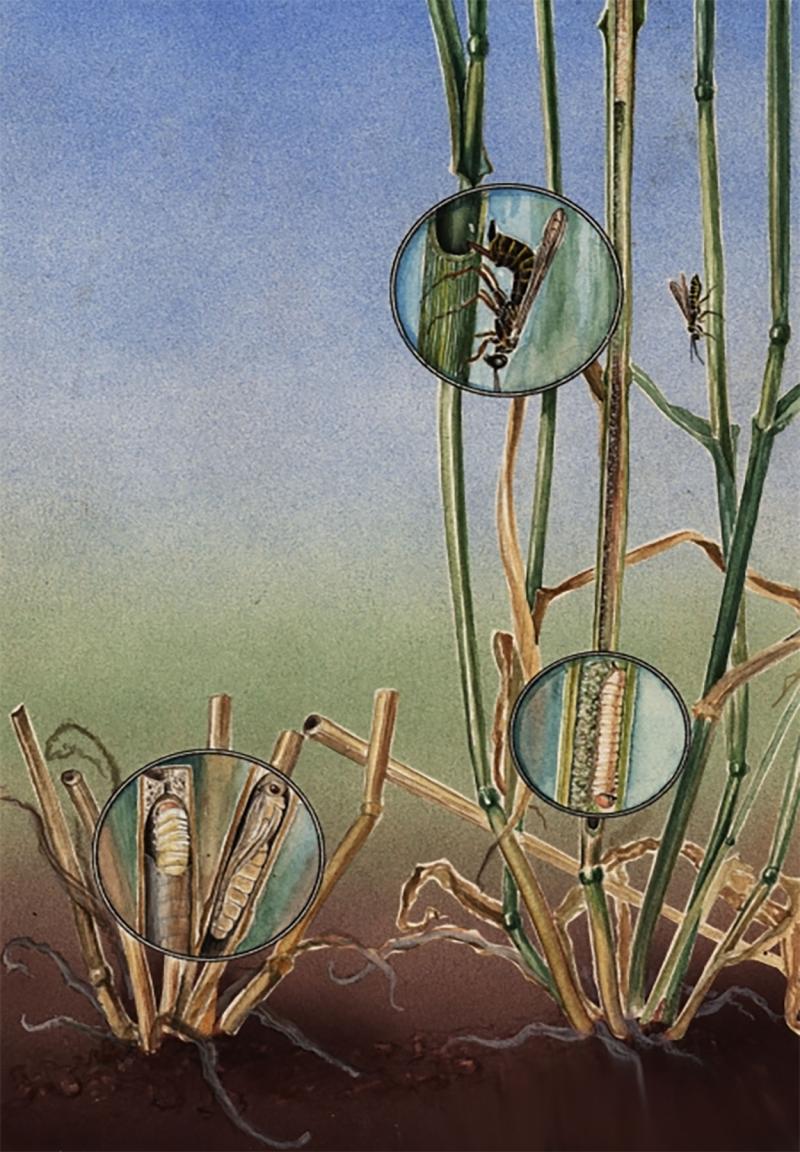
Wheat stem sawflies produce one generation per year and undergo four life stages known as complete metamorphosis (i.e. eggs, larva, pupa, adult) (Figure 3). Adult wheat stem sawflies begin to emerge from May or when temperatures exceed 62 degrees Fahrenheit, with emergence spanning a period of three to four weeks. The adults emerge from their overwintering sites within wheat stubble. They live for about one week total.
Mating does not need to occur to produce eggs, however, unmated females produce male eggs while mated females produce female eggs. Eggs are laid into the stem of a wheat plant, however, due to cannibalism, only one larva will survive per plant. The sole surviving larva feeds within the wheat stem while undergoing four to five growth stages (i.e. instars).
Mature larvae migrate down to the bottom of the wheat stems as they begin to dry out. Once at the bottom of the stem, the mature larvae create a V-shaped notch and then plug the hole above them. After the plug is in place, the larvae spin a protective cocoon in preparation for overwintering. Once spring arrives, overwintered larvae will begin to pupate, which can last for a couple of weeks. Finally, adult wheat stem sawflies emerge in early summer to start the lifecycle all over again.
Plant Damage
When wheat stem sawfly larvae hatch, they immediately begin to feed on plant material within the wheat stem. This type of direct feeding can reduce the overall seed weight. Once the larvae become mature, and feeding ceases, they move down near the soil line and cut a V-shaped notch around the inside of the stem. The V-shaped notch makes the wheat stem extremely vulnerable to lodging and completely breaking off (Figure 3). Lodging is responsible for most of the yield losses associated with wheat stem sawfly activity, as it makes harvesting difficult, if not impossible.
Scouting
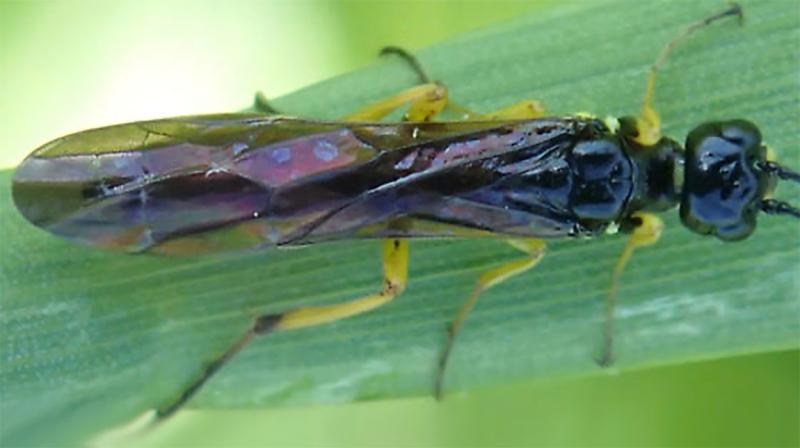
Adult wheat stem sawflies are considered weak fliers and typically use wind to help them disperse to nearby host plants. Due to this, it is common for margins or field edges to have higher populations compared to other parts of the field. When at rest, wheat stem sawfly adults will hold onto the plant and face the ground (Figure 4). A common, standard sweep net can be used to obtain samples and determine presence of adults. However, unless samples are taken over the entirety of the adult emergence period, it isn’t possible to determine population size with certainty. Another way to determine presence of wheat stem sawflies is to look for larvae within stems prior to harvest. Simply uproot wheat plant samples, split the stems open and look for an S-shaped larva. It’s important to not only scout for the presence of individuals, but to observe the type of damage occurring to the plant. When it comes close to harvest, scout wheat stems that appear lodged or are completely broken off a couple inches above the soil line. Rescue treatments are not available once wheat has been infested with wheat stem sawfly, making it very important to closely monitor fields and plan ahead for next seasons’ crops.
Management
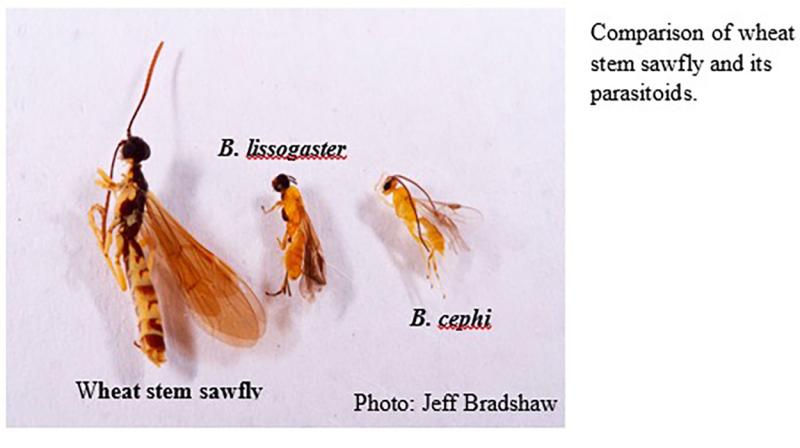
Resistant Cultivars
- Resistant wheat varieties for sawfly exist with a trait known as “solid stem.”
- The solid stem trait does not allow the larval to freely feed, which ultimately reduces movement, development and survivability.
Crop Rotation
- Avoid planting wheat near a field that suffered the previous year from wheat stem sawfly infestation.
- The previous years’ stubble could potentially still have a large overwintering population of wheat stem sawfly. Instead, plant non-host crops (i.e. corn, sunflower, sorghum and soybean).
Biological Control
- There are a few known insects that feed on wheat stem sawfly larvae. Some of these include Bracon lissogaster and Bracon cephi, both of which are parasitic wasps (Figure 5).
- The larval wasps’ life stages are known to feed on the larval wheat stem sawfly life stages within the stems.
References
- Best Management Practices for Wheat Production, Chapter 22 – Insect Pests of Wheat, Sue Blodgett and Jon Kieckhefer, SDSU Extension.
- Integrated Pest Management of Wheat Stem Sawfly in North Dakota, NDSU Extension.
- The High Plains Integrated Pest Management Guide, bugwood.org.
